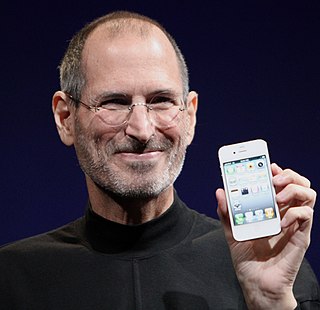Related Research Articles

Apple Inc. is an American multinational corporation and technology company headquartered in Cupertino, California, in Silicon Valley. It designs, develops, and sells consumer electronics, computer software, and online services. Devices include the iPhone, iPad, Mac, Apple Watch, Vision Pro, and Apple TV; operating systems include iOS, iPadOS, macOS, watchOS, tvOS, and visionOS; and software applications and services include iTunes, iCloud, Apple Music, and Apple TV+.
HyperCard is a software application and development kit for Apple Macintosh and Apple IIGS computers. It is among the first successful hypermedia systems predating the World Wide Web.

Lisa is a desktop computer developed by Apple, released on January 19, 1983. It is generally considered the first mass-market personal computer operable through a graphical user interface (GUI). In 1983, a machine like the Lisa was still so expensive that it was primarily marketed to individual and small and medium-sized businesses as a groundbreaking new alternative to much bigger and more expensive mainframes or minicomputers such as from IBM, that either require additional, expensive consultancy from the supplier, hiring specially trained personnel, or at least, a much steeper learning curve to maintain and operate. Earlier GUI-controlled personal computers were not mass-marketed; for example, Xerox PARC manufactured its Alto workstation only for Xerox and select partners from the early to mid-1970s.

MacPaint is a raster graphics editor developed by Apple Computer and released with the original Macintosh personal computer on January 24, 1984. It was sold separately for US$195 with its word processing counterpart, MacWrite. MacPaint was notable because it could generate graphics that could be used by other applications. It taught consumers what a graphics-based system could do by using the mouse, the clipboard, and QuickDraw picture language. Pictures could be cut from MacPaint and pasted into MacWrite documents.

The Macintosh II is a personal computer designed, manufactured, and sold by Apple Computer from March 1987 to January 1990. Based on the Motorola 68020 32-bit CPU, it is the first Macintosh supporting color graphics. When introduced, a basic system with monitor and 20 MB hard drive cost US$5,498. With a 13-inch color monitor and 8-bit display card the price was about US$7,145. This placed it in competition with workstations from Silicon Graphics, Sun Microsystems, and Hewlett-Packard.

A/UX is a Unix-based operating system from Apple Computer for Macintosh computers, integrated with System 7's graphical interface and application compatibility. It is Apple's first official Unix-based operating system, launched in 1988 and discontinued in 1995 with version 3.1.1. A/UX requires select 68k-based Macintosh models with an FPU and a paged memory management unit (PMMU), including the Macintosh II, SE/30, Quadra, and Centris series.
Macworld/iWorld was an information technology trade show with conference tracks dedicated to Apple's Mac platform. It was held annually in the United States during January. Originally Macworld Expo and then Macworld Conference & Exposition, the gathering dates back to 1985. The conference was organized by International Data Group (IDG), co-publisher of Macworld magazine.
MacWrite is a WYSIWYG word processor application released along with the first Apple Macintosh systems in 1984. Together with MacPaint, it was one of the two original "killer applications" that propelled the adoption and popularity of the GUI in general, and the Mac in particular.

The Macintosh, later rebranded as the Macintosh 128K, is the original Macintosh personal computer, from Apple. It is the first successful mass-market all-in-one desktop personal computer with a graphical user interface, built-in screen, and mouse. It was pivotal in establishing desktop publishing as a general office function. The motherboard, a 9 in (23 cm) CRT monochrome monitor, and a floppy drive are in a beige case with integrated carrying handle; it has a keyboard and single-button mouse.

Apple Inc., originally Apple Computer, Inc., is a multinational corporation that creates and markets consumer electronics and attendant computer software, and is a digital distributor of media content. Apple's core product lines are the iPhone smartphone, iPad tablet computer, and the Macintosh personal computer. The company offers its products online and has a chain of retail stores known as Apple Stores. Founders Steve Jobs, Steve Wozniak, and Ronald Wayne created Apple Computer Co. on April 1, 1976, to market Wozniak's Apple I desktop computer, and Jobs and Wozniak incorporated the company on January 3, 1977, in Cupertino, California.
The Apple Pugetsound Program Library Exchange (A.P.P.L.E.) is a users' group established in 1978 by Val Golding.

SuperPaint is a graphics program capable of both bitmap painting and vector drawing. SuperPaint was one of the first programs of its kind, combining the features of MacPaint and MacDraw while adding many new features of its own.

The Boston Computer Society (BCS) was an organization of personal computer users, based in Boston, Massachusetts, U.S., that ran from 1977 to 1996. At one point, it was the largest such group in the world, with regular user group meetings, many publications, permanent offices in Boston, and hosting major product announcements, including the East Coast release of the Apple Macintosh in 1984.
A Macintosh User Group (MUG) is a users' group of people who use Macintosh computers made by Apple Inc. or other manufacturers and who use the Macintosh operating system (OS). These groups are primarily locally situated and meet regularly to discuss Macintosh computers, the Mac OS, software and peripherals that work with these computers. Some groups focus on the older versions of Mac OS, up to Mac OS 9, but the majority now focus on the current version of Mac operating system, macOS.

Steven Paul Jobs was an American businessman, inventor, and investor best known for co-founding the technology company Apple Inc. Jobs was also the founder of NeXT and chairman and majority shareholder of Pixar. He was a pioneer of the personal computer revolution of the 1970s and 1980s, along with his early business partner and fellow Apple co-founder Steve Wozniak.

The Berkeley Macintosh Users Group, or more commonly "BMUG", was the largest Macintosh User Group. It was founded in September 1984 by a group of UC Berkeley students including Reese Jones and Raines Cohen as a focal-point for the nascent Apple Macintosh user community. With more than 13,000 members, or "BMUGgers" at its peak in 1993, the group was the largest, and generally understood to be the most important, Macintosh users group. A few of the notable members include John "Captain Crunch" Draper, the Sultan of Brunei Hassanal Bolkiah, notorious murderer Enrique Zambrano, early hacker-chaser Cliff Stoll, Inktomi founder Eric Brewer, and may prominent computing journalists like John Dvorak, Ilene Hoffman, Leo Laporte and Adam Engst. An example of the group's omnipresent blue-floppy-disk lapel pin is held in the Smithsonian Institution's American History collection. BMUG's history and activities were closely linked with the MacWorld Expo meetings, traditionally held in San Francisco each January and Boston each August.

Mac, short for Macintosh, is a family of personal computers designed and marketed by Apple. The name Macintosh is a reference to a type of apple called McIntosh. The product lineup includes the MacBook Air and MacBook Pro laptops, and the iMac, Mac Mini, Mac Studio, and Mac Pro desktops. Macs are sold with the macOS operating system.

Mac OS is the series of operating systems developed for the Macintosh family of personal computers by Apple Computer, Inc. from 1984 to 2001, starting with System 1 and ending with Mac OS 9. The Macintosh operating system is credited with having popularized the graphical user interface concept. It was included with every Macintosh that was sold during the era in which it was developed, and many updates to the system software were done in conjunction with the introduction of new Macintosh systems.

Ellen Petry Leanse is an American author, businesswoman, educator, entrepreneur, and online community pioneer. Leanse has spent 35 years working with leaders at Apple, Google, Facebook, as an entrepreneur, and with dozens of startups. She's a writer on topics of workplace dynamics and a Stanford instructor. Her work has spanned entrepreneurship, corporate leadership, investing, and strategy consulting.
References
- ↑ Lexerd (Drexel University). "Be careful that your Apple doesn't byte you". archives.library.drexel.edu. Drexel University Archives Digital Collections. Retrieved 18 June 2014.
- ↑ Joseph Master. "When the Mac Came to Market Street: The Story of the Drexel Microcomputing Program". www.lebow.drexel.edu. paragraph 21: LeBow College of Business, Drexel University. Retrieved 18 June 2014.
{{cite web}}: CS1 maint: location (link) - ↑ "Access for Everyone: Computing at Drexel, 1946-1984". archives.library.drexel.edu. Drexel University Libraries. Retrieved 18 June 2014.
- ↑ Mace, Scott (June 4, 1984). "Creating a Campus Users' Group". InfoWorld. 6 (23). InfoWorld Media Group, Inc.: 25. ISSN 0199-6649.
- ↑ History of TechServ